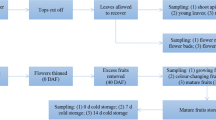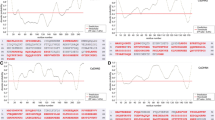Abstract
Heat-shocked maize seedlings (cv. Oh43) synthesize a characteristic set of heat-shock proteins (hsps) which include an 18 kDa family containing at least six major isoelectric variants. A cDNA library was constructed from poly(A)+ RNAs isolated from the radicles of heat-shocked maize seedlings and screened with a DNA fragment from the theoretical open reading frame of a putative Black Mexican Sweet maize hsp 18 genomic clone. Two clones, cMHSP18-3 and cMHSP18-9, were isolated, and the RNA transcripts generated from them were translated into proteins which immunoreact with antibodies directed against the maize 18 kDa hsps and exhibit the same electrophoretic characteristics as two different members of the 18 kDa hsp family. Nucleotide sequence analyses of the cDNAs in these clones reveal that their 5′ and 3′ untranslated regions exhibit 33–34% identity and that their protein encoding regions share 93% identity. The deduced amino acid sequences of these clones show 90% identity, and the apparent molecular masses and isoelectric points of these proteins agree with those established for two different 18 kDa hsps, numbered 3 and 6. This report substantiates that at least two of the 18 kDa hsps in maize are products of different but related genes. Moreover, it establishes that transcripts for these proteins accumulate during heat shock and that both their nucleotide and deduced amino acid sequences share extensive similarities with the class VI small hsps in soybean and with transcripts expressed during meiosis in Lilium.
Similar content being viewed by others
References
Arrigo AP, Welch WJ: Characterization and purification of the small 28, 000-dalton mammalian heat shock protein. J Biol Chem 262: 15359–15369 (1987).
Atkinson BG, Liu L, Goping IS, Walden DB: Expression of the genes encoding HSP73, HSP18 and ubiquitin in radicles of heat-shocked maize seedlings. Genome 31: 699–704 (1989).
Atkinson BG, Walden DB: Changes in Eukaryotic Gene Expression in Response to Environmental Stress. Academic Press, New York (1985).
Barker RF, Harberd NP, Jarvis MG, Flavell RB: Structure and evolution of the intergenic region in the ribosomal DNA repeat unit of wheat. J Mol Biol 201: 1–17 (1988).
Baszczynski CL: Immunochemical analysis of heatshock protein synthesis in maize (Zea mays L.). Can J Gen Cytol 28: 1076–1087 (1988).
Baszczynski CL, Walden DB, Atkinson BG: Regulation of gene expression in corn (Zea mays L.) by heat shock. Can J Biochem 60: 569–579 (1982).
Baszczynski CL, Walden DB, Atkinson BG: Regulation of gene expression in corn (Zea mays L.) by heat shock II. In vitro analysis of RNAs from heat-shocked seedlings. Can J Biochem 61: 393–403 (1983).
Baszczynski CL, Walden DB, Atkinson BG: Maize genome response to thermal shifts. In: Atkinson BG, Walden DB (eds) Changes in Eukaryotic Gene Expression in Response to Environmental Stress, pp. 349–875. Academic Press, New York (1985).
Berger EM, Woodward MP: Small heat shock proteins in Drosophila may confer thermal tolerance. Exp Cell Res 147: 437–442 (1983).
Bond U, Schlesinger MJ: Heat-shock proteins and development. Adv Genet 24: 1–29 (1987).
Bouchard RA: Characterization of expressed meiotic prophase repeat transcript clones of Lilium: meiosisspecific expression, relatedness, and affinities to small heat shock protein genes. Genome 33: 69–79 (1990).
Chan Y-L, Olivera J, Wool IG: The structure of rat 28S ribosomal ribonucleic acid inferred from the sequence of nucleotides in a gene. Nucl Acids Res 11: 7819–7831 (1983).
Craig EA: The heat shock response, CRC Critical Rev Biochem 18: 239–280 (1985).
Devereux J, Haeberli P, Smithies O: A comprehensive set of sequence analysis programs for the VAX. Nucl Acids Res 12: 387–416 (1984).
Dietrich PS, Bouchard RA, Silva EM, Sinibaldi RM: The complete sequence of a maize 18 kd heat shock gene. J Cell Biol 105: 245a (1987).
Fransolet S, Deltour R, Bronchart R, van de Walle C: Changes in ultra-structure and transcription induced by elevated temperatures in Zea mays embryonic root cells. Planta 146: 7–18 (1979).
Georgiev OI, Nikeleav N, Hadjiolov AA: The structure of the yeast ribosomal RNA genes. 4. Complete sequence of the 25S rRNA gene from Saccharomyces cerevisiae. Nucl Acids Res 9: 6953–6958 (1981).
Helm KW, Vierling E: An Arabidopsis thaliana cDNA clone encoding a low molecular weight heat shock protein. Nucl Acids Res 17: 7995 (1989).
Hopp TP, Woods KR: Prediction of protein antigenic determinants from amino acid sequences. Proc Natl Acad Sci USA 78: 3824–8828 (1981).
Ingolia TD, Craig EA: Four small Drosophila heat shock proteins are related to each other and to mammalian α-crystallin. Proc Natl Acad Sci USA 79: 2360–2364 (1982).
Jain SK, Crampton J, Gonzalez IL, Schmickel RD, Drysdale JW: Complementarity between ferritin H mRNA and 28S ribosomal RNA. Biochem Biophys Res Comm 131: 863–867 (1985).
Key JL, Kimpel JA, Lin CY, Nagao RT, Vierling E, Czarnecka E, Gurley WB, Roberts JK, Mansfield MA, Edelman L: The heat shock response in soybean. In: Key JL, Kosuge T (eds). Molecular Biology of Plant Stress, pp. 161–179. Alan R. Liss, New York (1985).
Kolosha VO, Kryukov VM, Fodor I: Sequence analysis of Citrus limon DNA coding for 26S rRNA. Evidence of heterogeneity in the 3′-region. FEBS Lett 197: 89–92 (1986).
Kurtz S, Rossi J, Petko L, Lindquist S: An ancient developmental induction: heat shock protein induced in sporulation and oogenesis. Science 231: 1154–1157 (1986).
Landry J, Chrétien P, Lambert H, Hickey E, Weber LA: Heat shock resistance conferred by expression of the human HSP27 gene in rodent cells. J Cell Biol 108: 7–15 (1989).
Leicht BG, Biessmann H, Palter KB, Bonner JJ: Small heat shock proteins of Drosophila associate with the cytoskeleton. Proc Natl Acad Sci USA 83: 90–94 (1986).
Lin CY, Roberts JK, Key JL: Acquisition of thermotolerance in soybean seedlings. Plant Physiol 74: 152–160 (1984).
Lindquist S: The heat-shock response. Ann Rev Biochem 55: 1151–1191 (1986).
Loomis WF, Wheeler SA: Heat shock response of Dictostelium. Develop Biol 90: 412–418 (1982).
Lutcke HA, Chow KC, Mickel FS, Moss KA, Kern HF, Scheele GA: Selection of AUG initiation codons differs in plants and animals. EMBO J 6: 43–48 (1987).
Maniatis T, Fritsch EG, Sambrook J. Molecular Cloning: A Laboratory Manual. Cold Spring Harbor Laboratory, Cold Spring Harbor, New York (1982).
Mansfield MA, Key JL: Synthesis of the low molecular weight heat shock proteins in plants. Plant Physiol 84: 1007–1017 (1087).
Mascarenhas JP: The male gametophytre of flowering plants. Plant Cell 1: 657–664 (1989).
McMullen MD, Hunter B, Phillips RL, Rubenstein I: The structure of the maize ribosomal DNA spacer region. Nucl Acids Res 14: 4953–4968 (1986).
Nagao RT, Czarnecka E, Gurley WB, Schöffl F, Key JL: Genes for low-molecular weight heat shock proteins of soybeans: Sequence analysis of a multigene family. Mol Cell Biol 5: 3417–3428 (1985).
Neumann D, Nover L, Parthier B, Rieger R, Scharf K-D, Wollgiehn R, Nieden UZ: Heat shock and other stress response systems of plants. Biol Zentralbl 108: 1–156 (1989).
Nover L, Scharf K-D, Neumann D: Cytoplasmic heat shock granules are formed from precursor particles and are associated with a specific set of mRNAs. Mol Cell Biol 9: 1298–1308 (1989).
Pearson WR, Lipman DJ: Improved tools for biological sequence comparison. Proc Natl Acad Sci USA 85: 2444–2448 (1988).
Puissant C, Houdebine L-M: An improvement of the single-step method of RNA isolation by acid guandinium thiocyanate-phenol-chloroform extraction. Biotechniques 8: 148–149 (1990).
Raschke E, Baumann G, Schöffl F: Nucleotide sequence analysis of soybean small heat shock protein genes belonging to different multigene families. J Mol Biol 199: 549–557 (1988).
Ricciardi RP, Miller JS, Roberts BE: Purification and mapping of specific mRNAs by hybridization-selection and cellfree translation. Proc Natl Acad Sci USA 76: 4927–4931 (1979).
Sanger F, Nicklen S, Coulson AR: DNA sequencing with chain terminating inhibitors. Proc Natl Acad Sci USA 74: 5463 (1977).
Shah DM, Rochester DE, Krivi GG, Hironaka CM, Mozer TJ, Fraley RT, Tiemeier DC: Structure and expression of maize HSP70 genes. In: Key JL, Kosuge T (eds) Cellular and Molecular Biology of Plant Stress, pp. 181–200. Alan R. Liss, New York (1985).
Shine J, Dalgarno L: The 3′-terminal sequence of Escherichia coli 16S ribosomal RNA: Complementarity to nonsense triplets and ribosome binding sites. Proc Natl Acad Sci USA 71: 1342–1346 (1974).
Southgate R, Mirault ME, Ayme A, Tissières A: Organization, sequences, and induction of heat shock genes. In: Atkinson BG, Walden DB (eds) Changes in Eukaryotic Gene Expression in Response to Environmental Stress, pp. 3–30. Academic Press, New York (1985).
Takaiwa F, Oono K, Iida Y, Sugiura Y: The complete nucleotide sequence of a rice 25S rRNA gene. Gene 37: 255–259 (1985).
Vierling E, Nagao RT, De Rocher AE, Harris LM: A heat shock protein localized to chloroplasts is a member of a eukaryotic superfamily of heat shock proteins. EMBO J 7: 575–581 (1988).
Wistow G: Domain structure and evolution in α-crystallin and small heat shock proteins. FEBS Lett 181: 1–6 (1985).
Zimmerman JL, Petri W, Meselson M: Accumulation of a specific subset of D. melanogaster heat shock mRNAs in normal development without heat shock. Cell 32: 1161–1170 (1983).
Author information
Authors and Affiliations
Rights and permissions
About this article
Cite this article
Goping, I.S., Frappier, J.R.H., Walden, D.B. et al. Sequence, identification and characterization of cDNAs encoding two different members of the 18 kDa heat shock family of Zea mays L.. Plant Mol Biol 16, 699–711 (1991). https://doi.org/10.1007/BF00023434
Accepted:
Issue Date:
DOI: https://doi.org/10.1007/BF00023434




